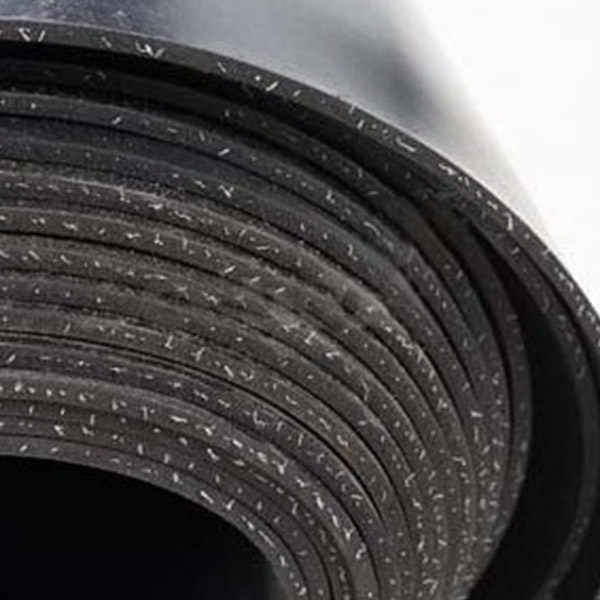
Kaxite manufactures Hard Mica Sheet. For every 1/16” of EPDM, a one ply layer of fabric such as nylon, lightweight nylon or fiberglass. Cloth-inserted rubber adds enhanced stability and reduces gasket creep. It is perfect for belts and gaskets that are exposed to moisture and harsh weather conditions.
The composition of cloth inserted EPDM rubber sheet is ideal for mechanical fastening gaskets. Cloth inserted EPDM offers the same properties as conventional EPDM rubber, such as weather resistance, with the enhanced stability of cloth inserted products.
Cloth inserted EPDM rubber sheet adds durability and enhanced strength under hot or cold loads and is commonly used for gasketing applications. Additional uses for cloth inserted EPDM rubber include conveyor belts and high strength diaphragms
We also offers fiberglass inserted EPDM that is known for its durability in applications requiring gasket stability. The fiberglass reduces gasket creep in applications where heavy pipe, joint or structure loading occurPDM rubber material sheet is a great weather resistant material.
Inserted cloth Fabric: Nylon, glassfiber, cotton or other fabrics
Advantages
• Inserted cloth fabric adds durability and enhance strength of EPDM
• Will not deteriorate when submerged in fresh or seawater
• Good mechanical, and wear resistance properties
• Excellent chemical resistance to acids and alkalis
• Good high and low temperature resistance
• Ideal for long term outdoor applications
• Very durable and long time usage
• Good low electrical conductivity
• Good Tensile Strength
• Excellent color stability
Application
• Harsh extremes as marine and underwater applications
• UV, ozone and general weathering applications
• High temperature water environments
• Pipe gasket seals and weather strips
• Outdoor and automotive applications
• Good for use with drinking water
• high strength diaphragm
• Conveyor belts
EPDM rubber Properties
|
Item |
EPDM |
Test Method |
|
Inserted |
Nylon/glassfiber |
|
|
Specific gravity |
1.5g/cm3 |
ASTM D297 |
|
Hardness |
70 Shore A |
ASTM D2240 |
|
Tensile strength |
10 MPa (min) |
ASTM D412 |
|
Elongation at break |
350% (min) |
ASTM D412 |
|
Width |
1m, 1.2m or 1.5m |
|
|
Tear strength |
40 N/mm |
ASTM D 624 |
|
Low temperature resistance |
-50°C |
ASTM D1329 |
|
Temperature range |
-30°C to + 120°C |
ASTM D2000 |
Kinds of Rubber Properties
|
Common name |
Neoprene |
EPDM |
Nitrile |
Silicone |
Viton |
Kalrez |
|
Chemical Compatibility |
||||||
| Lubricating and Fuel Oils |
|
X |
|
X |
|
|
| Hydraulic Oils |
|
X |
|
|
|
|
| Fireproof Hydraulic Fluids |
|
|
|
|
X |
|
| Vegetable Oils, Animal Fats |
|
|
|
|
|
|
| Gasoline (high octane) |
 X X
|
X |
 
|
X |
|

|
| Kerosene |

|
X |

|
X |
|

|
| Aromatic Hydrocarbons | X | X |
 X X
|
X |
|

|
| Aliphatic Hydrocarbons |

|
X |

|
X |
|

|
| Alcohols |

|
|

|
|
|

|
| Ketones |
 X X
|

|
X | X | X |

|
| Halogenated Solvents | X | X | X | X |

|

|
| Water (>80°C) |

|

|

|

|
|

|
| Concentrated Acids | X | X | X | X |
|

|
| Diluted Acids |
|
|
 X X
|
X |
|

|
| Alkalis |
 
|

|
|
|
X |

|
|
Properties |
||||||
| Max. Continuous temp °C | 105 | 130 | 121 | 204 | 250 | 316 |
| Low Temperature °C | –50 | –54 | –25 | –85 to –125 | –8 to -30 |
–8
|
| Tensile Strength, MPa | 25 | 17 | 27 | 10 | 20 | 15 |
| Hardness Shore A | 30–95 | 40–90 | 40–95 | 30–90 | 70–90 | 65-95 |
Key:  = Excellent ,
= Excellent ,  = Good,
= Good,  = Fair, X = Not Recommended
= Fair, X = Not Recommended